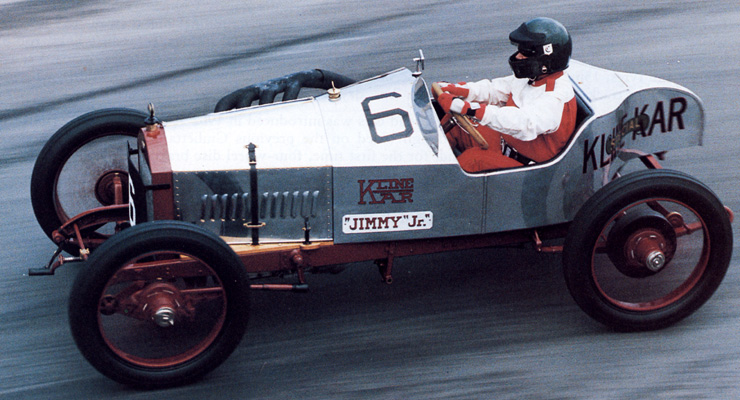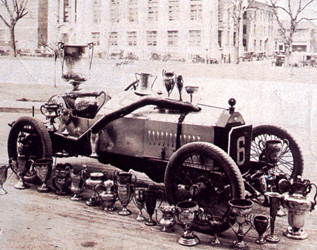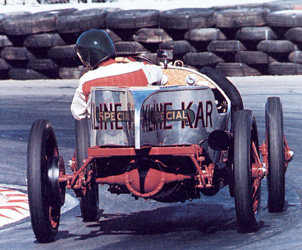1919 Kline-Duesenberg
|
|
Start with a winner. |
End with a winner. |

Technically, this early racer is a Kline Kar, built by James Kline in Richmond, Virginia. It was first built in 1910 and was part of a pair of race cars they called "Jimmy" and "Jimmy Jnr." which were raced with Kline engines.
In 1914 James Kline convinced the Duesenberg brothers that he should have one of their new Rochester-Duesenberg engines because he (Kline) would bring fame and fortune to both himself and the Duesenbergs.
This Kline-Duesenberg won as many as 19 races between 1914 and 1919, mostly on dirt or board tracks, on the east coast, and were short duration events or match races.
This Kline racer, formerly "Jimmy Jnr.," was somewhat typical of the time, in having a channel steel frame, semi-elliptic springs and beam axles at each end, with brakes on just the rear wheels.
The Duesenberg four-cylinder "walking beam" engine was normally built with eight valves, but three high performance engines were constructed with 16 valves, and this Kline-Duesenberg is the first car to race with the 16-valve Duesenberg engine.
The valves are horizontal, intake on the left, exhaust on the right. Because the block and head are one piece, the smaller exhaust valves are installed through the holes where the intake valves will go. Once the exhaust valves are in place and set for clearance, the intake valves and their seats are installed as an assembly, the seats screwing into the cylinder head.
The original engine design called for dip, or splash lubrication for the crankshaft and connecting rods, but a small oil pressure pump was mounted inside the crankcase to provide oil to the camshafts. This location was used to fit a pressure pump for a dry sump system, in the interests of reliability, when the engine was restored at Phil Reilly's shop in California.
During restoration it was also discovered that the original connecting rods were beyond salvation, so duplicate rods were made, still running on babbited bearing surfaces. Fuel (pump gasoline) is fed to the Miller carburetor by gravity, the tank being in the cowl between the firewall and the instrument panel. A Stewart-Warner cylinder-type tachometer was used.
Drive from the engine goes through a cone-clutch, the lining changed from the original asbestos to carbon fibre, again, in the interests of durability for vintage car racing.
At the 1990 Monterey Historic races the car won "The Outstanding Restoration" award, and the same year won the "Pebble Beach Cup" at the Concours d'Elegance. Chassis and body restoration were by Stu Laidlaw, engine restoration by Phil Reilly.
This Kline-Duesenberg is one of the rarest racing cars of the period, and arguably one of the more successful cars from that period. It is a good-running racer with excellent performance and provenance, and can be successfully raced in vintage events, or shown in its present immaculate condition.
| Engine; Duesenberg four-cylinder "walking beam" design. 300 cu. in. displacement (4,918 c.c.). The cylinder block and head are a monobloc design of cast-iron while the barrel-type crankcase is made of cast aluminum. The crankshaft runs in two ball-bearing races, one at each end of the shaft. Two gear-driven camshafts, also turning in ball-bearing races, are mounted low in the engine (one on each side) and operate eight intake valves on one side, eight exhaust valves on the other side via 12-inch long rocker arms. Carburetion is a single Miller carburetor. The connecting rods are babbited and the original lubrication was by splash, but in restoration a dry-sump pressure oiling system was added in the interest of reliability. The body is of two-passenger configuration. Dimensions: wheelbase 8 ft. 4 in., track 4 ft. 10 in. |


